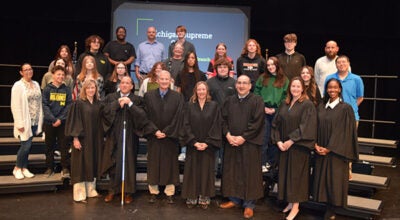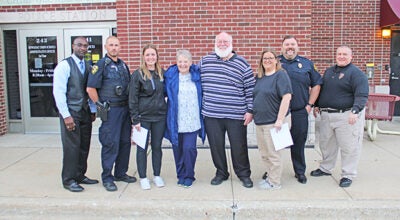Rosetta here for cheetah installation
Published 8:38 am Wednesday, September 9, 2009

Jan Rosetta
By JOHN EBY
Dowagiac Daily News
Loveland, Colo., sculptor Jan Rosetta was in Dowagiac Sept. 8 to oversee this morning’s installation of “Cheetahs on the Run,” which will be unveiled at 11 a.m. Friday, Sept. 11, on the grassy knoll at the corner of E. Division Street and Depot Drive.
Rosetta also created Stone Lion in Beckwith Park for the William F. Moran family.
Stone Lion was dedicated May 13, 2002.
In an interview at the Daily News Tuesday afternoon, she said the three big, bronze cats will occupy an area 32 feet long.
Dalton’s St. Denys Foundation is organizing the “celebration of a life well-lived” for the memorial to cat-lover Helen R. Tremble.
A barbecue lunch follows the dedication.
“I’ve probably done more cheetahs than anything,” Rosetta said. “Thelda (Mathews, chair of the Dogwood Fine Arts Festival Visual Arts Committee) called me and said, ‘We have this long, skinny piece of land to place some sculpture. Helen Tremble loved cats and had been to Africa,” so the idea evolved to honor her with felines “racing along this grassy knoll” parallel to high-speed trains on the railroad tracks.
“I said, ‘They need to be cheetahs, because that’s what cheetahs are known for,’ ” Rosetta recalled.
“It just seemed perfect for Helen,” agreed Denise Wierman of the Visual Arts Committee. “She had inside cats, outside cats and kept every stray kitty that came her way. They rescued them right and left. Cats were Helen’s thing. I don’t ever remember her having a dog, but cats were important to her and travel was important to her. And she loved art.”
“She made three trips to Africa,” Mathews added.
Tuck Langland was the first sculptor with more than one piece in Dowagiac’s collection, Dance of Creation in Farr Park in 1995 as a gift of the Tremble and Dalton families and Resting Dancer by City Hall in 1999 as a gift of the Harold B. Franklin family.
Three cheetahs acknowledge how the animals sometimes hunt together.
“Cheetahs are the fastest land animal and have a distinctive running style,” Rosetta said. “The three poses I chose are components of this famous running style. One, where the legs are gathered up underneath with the back arched, ready to spring. It springs out airborne like a leap rather than a run. That’s how they cover incredible amounts of territory. The other thing that’s amazing about them is that they can turn on a dime when they’re going that fast after their prey. The only time you can see it is when people film it and run it in slow motion, which they do all the time on nature shows. I’ve been to Africa three times and seen cheetahs, but you don’t see much. They’re running too fast.”
“I’m not doing a sculpture from a photograph,” Rosetta said. “I’m doing it from what I know about the cat and what I want to show. It’s like if you see a person walking that you know, and you see them from the back. You say, ‘That’s so and so, because I know how they move.’ You have a familiarity with them, so that when I am working on a sculpture, I can say, ‘Now, wait a minute, that paw wouldn’t look like that. It would curve in.’ It’s a feeling that helps with familiarity with the subject.”
The cheetahs are free-standing, she said. “They’re in a line. Two of them are running straight. The one that’s turning that’s in the lead, its tail is in line with the others.”
The third cheetah in this series resembles one at a corporation in San Diego which uses the big cat as its mascot.
“But this project is the first time I’ve done any of these this large,” Rosetta said. “I do have a pair of seated cheetahs that are about the same size as these. They’re like mirror images, facing each other. But they’re all (privately owned) except at the Champaign-Urbana (Ill.) transit center. They have a pair of seated cheetahs.”
“We first talked about doing this in late ’07,” she said. “It’s been almost two years. I started by enlarging the existing one. Then I had to create the other two from scratch. I make them small in clay first. I do a three-dimensional clay ‘sketch’ to establish the pose and the proportions. Then I do what I call tabletop size – 15 to 20 inches long. Because I’ve done the little sketch, I know what kind of armature to create for support – pipes and wires to hold the clay. On that one, I really establish the piece. In fact, I cast those maquettes in bronze and do an edition of that size,” Rosetta explained. “That’s what we use as a model for enlarging to the big size.”
Lately, “I’ve been having it done to about 80 percent by laser scanning and having it carved out of dense Styrofoam, with just a thin layer of clay on top, then I finish the piece. Then it goes through all of the steps for bronze – mold, wax poured, shell mold at the foundry, melt out the wax, pour in the bronze, break off the shell mold … there are a lot of steps. Then it goes to the patineur,” the person who applies the chemical patina.
“This is a specific recipe of high-grade bronze that is mostly copper,” she said of her castings. “The foundry deals with the metal. We, in Loveland, have an unusual situation where all of these different processes have free-lancers to do them outside the foundries, which only do the metal part if you want them to. The foundry I use does the cast only.
There are a lot of different ways to handle the process” developed over the past 40 years.
Rosetta has been sculpting almost 25 years. It has been fully her career since 1992.
She previously worked in graphic design.
“I was a freelance lettering designer” when she lived in Marin County, Calif., north of the Golden Gate Bridge.
“I worked for ad agencies and design studios in San Francisco,” Rosetta said. “I did trademarks and lettering for packaging and advertising logos. The very first bronze sculpture I did was a portrait head of a friend. The next one, just for me, just for fun, was a seated cheetah, a small version of the big ones down in Champaign-Urbana. The style was basically the style I’m doing now and it grew out of my graphic design. The idea is reducing details down to just the ones I choose as important. It was a smooth transition for me. I carved soap when I was a little kid. I always liked working in 3-D,” and computers sounded the death knell of her lettering business.
Rosetta was accompanied by her husband, Mel, who photographs artwork.
Her first big piece in an open competition for a commission took them to Loveland, “gateway to the Rocky Mountains.”
She won the commission and journeyed to Colorado to install the piece.
Rosetta learned that Loveland “was a bronze-casting community. There were art foundries and lots of bronze artists doing work there.”
It was May and she learned of a sculpture show coming up in August.
In fact, it was the country’s biggest such show.
“Put me in for next year,” she said. “I sat in my booth and Mel was out visiting. Real estate agents kept stopping by my booth and dropping off their cards. After about the third one I said, ‘Why are you giving me your card?’ ‘Your husband’s telling everyone you’re moving here.’ We talked about it during the two-day drive back to California” and decided to leave the home they designed and hand-built in the redwood forest.
“Because, believe it or not, for all the artists and the ‘art scene’ in the San Francisco bay area, it was like pulling teeth trying to get work cast, and very little bronze was being done. We had to go two hours in one direction for one thing and three hours in the other direction for another thing” – as far as Monterey. “The bay area had gotten so crowded. It wasn’t fun anymore.”
“There was a whole different feeling,” said Mel, who is originally from Chicago. “People coming in weren’t as nice” as time marched on from the mellow Sixties vibe to the Nineties.






